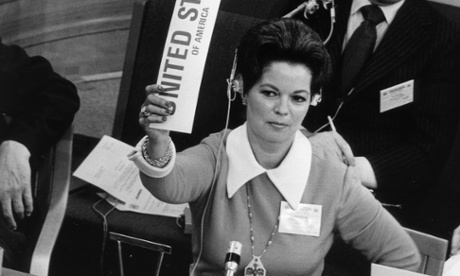
Shirley Temple’s achievements went beyond the film industry. She retired at 20 in order to forge a new life as a diplomat. Even there she left a mark, becoming the first woman to serve as chief of protocol for the White House.
She sang, danced, showed off perfect ringlets and above all, attained big ratings for Fox in the post-Great Depression America.
Her adult-like manners, ideal smile and way of frowning captivated thousands of admirers — she received an average of 16,000 letters a month — and saved the studio from going bankrupt by cashing in $1,250 a week.
However, Shirley Temple’s achievements went beyond the film industry; she retired at 20 to forge a new life as a diplomat. Even there she left a mark, becoming the first woman to serve as chief of protocol for the White House.
The little star was born on April 23, 1928 in Santa Monica, California. She was the daughter of a banker and a housewife. She made her debut when she was just 3 years old.
She starred in over 40 perfectly suited films such as “Poor Little Rich Girl” (1936) and “The Little Princess” (1939). She grabbed John Ford’s attention, who took her on to play the role of John Wayne’s daughter in “Fort Apache” (1948).
She was Gary Cooper and Carole Lombard’s daughter in the 1934 “Now and Forever,” a loan to Paramount, the orphan girl who sang the “Lollipop” song in “Bright Eyes” (1934), and the little girl who tap danced on the staircase with Bill “Bojangles” Robinson in “The Little Colonel” (1935).
She gained such success that even Salvador Dalí himself turned her into a surrealistic beast in one of his paintings. Besides, she was granted with a special Academy Award when she was just 6, thanks to her “outstanding qualities.”
Metro-Goldwyn-Meyer wanted her to star in the 1939 “The Wizard of Oz,” but Fox founder Darryl F. Zanuck refused the arrangement, and the role was offered to Judy Garland.
The truth is that the studio’s profits thanks to the little star were not limited to the box office; her songs also sold like hot cakes, and she even went as far as to advertise cereals, dresses and soap. The contract expired in 1940, and Temple retired nine years later.
Her political and diplomatic career took some time to get off the ground. During the 1960s, she began to collaborate with the Republican Party, and after a failed attempt to become a congresswoman for California in 1967, Temple held different diplomatic positions.
In 1969, President Nixon appointed her to the U.S. delegation of the United Nations; she was ambassador to Ghana between 1974 and 1975, when she became chief of protocol for the White House.
As an ambassador to Czechoslovakia (1989-1992), she witnessed the Velvet Revolution, a peaceful movement that led to the collapse of the Communist Party and the transition toward a democratic system.
She was also on the board of directors of several nonprofit companies, such as Walt Disney, the Institute for International Studies at Stanford University and the United States Commission for UNESCO.
At 17, she married sergeant-turned-actor John Agar, with whom she had a daughter, Susan. They divorced two years later, and Temple met her second husband, entrepreneur Charles Alden Black, whom she married that same year.
In 1972, she fought breast cancer. She spent her last years playing a part in the fight against cancer and revising her cinematographic legacy, which was included in her autobiography, “Child Star.”

Leave a Reply
You must be logged in to post a comment.